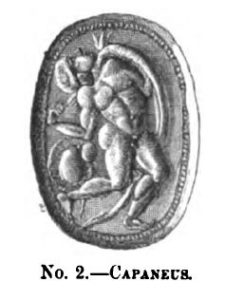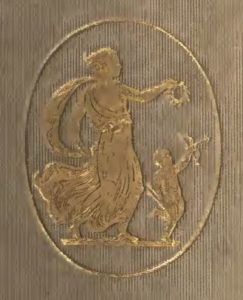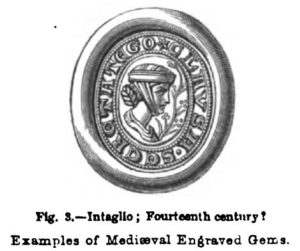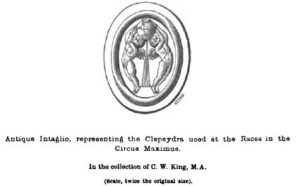CHARLES W. KING, M.A., Senior Fellow of Trinity College., Cambridge, (18Sep1818-25Mar1888) was a scholar who specialized in the Glyptic Arts. His writings remain, to this day, the definitive works concerning the history of carved gems. He was also a collector of the gems having a cabinet of over 300. The King collection, formed between 1845 and 1877 was presented to the Metropolitan Museum of Art in New York City in 1881 by John Taylor Johnston.
“Rev. C. W. King, of Trinity College, England, the greatest of all writers on engraved gems; …. Mr. King’s numerous writings mark an epoch in the study of this branch of archeology.”
“King was a famed Cambridge gemmologist whose early reference works Antique Gems and Rings (1872) and A handbook of engraved gems (1866) were amongst the most respected scholarly works on the subject in the second half of the 19th century. During sojourns in Italy and on the London market King acquired 331 antique gems himself, most of which now form the core of the Metropolitan Museum of Art’s collection. ” Sotheby’s London catalog, 2015.
1. THE KING COLLECTION OF ENGRAVED GEMS
“An expression used by the Rev. C. W. King, the most distinguished English collector, in regard to engraved antique gems, is a most happy one. Mr. King calls engraved gems ‘little monuments of antiquity.’’ This term ‘little’ is to be understood simply as a limit of size, for though the heads, the full – length figures and their surroundings, may be cut and carved on a stone no larger than a pea, yet the effects produced are as grand, impressive, as large, as if worked on a frieze or painted on the widest spreading canvas.”
monuments of antiquity.’’ This term ‘little’ is to be understood simply as a limit of size, for though the heads, the full – length figures and their surroundings, may be cut and carved on a stone no larger than a pea, yet the effects produced are as grand, impressive, as large, as if worked on a frieze or painted on the widest spreading canvas.”
Editors. “The King Collection of Engraved Gems.” Harper’s New Monthly Magazine No.CCCLII, September, 1879 VOL. LIX, Harper’s New Monthly Magazine (collected) Volume LIX, June-November, 1879, pp.549-558. https://books.google.com/books?id=4nYCAAAAIAAJ&pg=PA538&lpg=PA538&dq=glyptic+arts+c+w+king&source=bl&ots=_DgHoNR8E8&sig=UWVA8UhA3-oLZkHnqKE51gnvQ1Q&hl=en&sa=X&ved=0ahUKEwj35sX09KPQAhXC4SYKHabGCGg4ChDoAQglMAM#v=onepage&q&f=false , accessed 2016 11 12
The entire article can be accessed using the above noted link.
2. CHARLES W KING’S WRITINGS THROUGH 1870
Listing of Charles W. King’s works through 1870. From publication entitled THE FIRST PROOFS OF THE UNIVERSAL CATALOGUE OF BOOKS ON ART, Vol I – A to K London 1870 https://books.google.com/books?id=6cgKAQAAIAAJ&pg=PA990&lpg=PA990&dq=glyptic+arts+g+w+king&source=bl&ots=Lskscjq7fn&sig=nFKBv1ZoYcavARYh0FqtTEZ-Y-Y&hl=en&sa=X&ved=0ahUKEwjB3sqE3anQAhXC4yYKHUqgDFoQ6AEIIDAB#v=onepage&q&f=false
KING (CHARLES W.).—A Catalogue of Coins found at and near Shefford in the County of Bedford. 4to. Cambridge, 1845. Lond. Inst.
KING (CHARLES W.).—Antique Gems, their origin, uses, and value as interpreters of Ancient History, and as illustrative of Ancient Art, with Hints to Gem Collectors. With plates. 8vo. London, 1860. S.K.
KING (CHARLES W.).— Notices of Collections of Glyptic Art, exhibited by the Archaeological Institute of Great Britain and Ireland, in June, 1861. 8vo London, 1861. S.K.
KING (CHARLES W.).—Precious Stones and Antique Gems. From the ” Times,” October 14 and 17, 1865. S.K.
KING (CHARLES W.).—The Natural History, ancient and modern, of Precious Stones and Gems, and of the Precious Metals. Royal 8vo. London, 1865. S.K.
KING (CHARLES W.).—The Handbook of Engraved Gems. With numerous illustrations. 8vo. London, 1866. S.K.
KING (CHARLES W.).—Antique Gems. Article from tho ” Edinburgh Review,” No. 254, October 1866. S.K.
KING (CHARLES W.).—The Natural History of Gems or Decorative Stones. 8vo. London, 1867. S.K.
KING (CHARLES W.).—The Natural History of Precious Stones and of the Precious Metals. 8vo. London, 1867. S.K.
KING (CHARLES W.).—Notices of Collections of Glyptic Art exhibited by the Areheological Institute 1861. Bessborough Gems, etc. In ” Areheological Journal,'” vol. xviii. The same, vol. iix., Arundel Collection, p. 9 and p. 99.
KING (CHARLES W.). — Notice of an Intaglio representing the Clepsydra used at Races in the Circus Maximus. 1 illustration. The same, vol. xxi.
KING (CHARLES W.).—On Mediaeval Gem Engraving. With illustration. The same
3. REVIEW AND SUMMARY OF C.W. KING’S “ANTIQUE GEMS…”
“…though we might easily fall into the error of exaggerating the importance of this subject (Gems) as a department of archaeology or of aesthetics, archaeologists and students of art seem in our day, or at least in our country, to have gone to the other extreme, and to have somewhat undervalued the works of the gem-engraver. By the word ‘ Gem’ we understand, not alone the precious material of the stone, but the combination of that material with a work of art either cut in intaglio into the hard and grainless texture of the mineral, or standing in relief as a cameo upon it.”
(Gems) as a department of archaeology or of aesthetics, archaeologists and students of art seem in our day, or at least in our country, to have gone to the other extreme, and to have somewhat undervalued the works of the gem-engraver. By the word ‘ Gem’ we understand, not alone the precious material of the stone, but the combination of that material with a work of art either cut in intaglio into the hard and grainless texture of the mineral, or standing in relief as a cameo upon it.”
Editor’s Review (and Summary) of the book “Antique Gems: their Origin, Uses, and Value as Interpreters of Ancient History, and as illustrative of Ancient Art ; with Hints to Gem Collectors.” By the Rev. C. W. King, Fellow of Trinity College, Cambridge. London: 1860. Published in THE EDINBURGH REVIEW, OR CRITICAL JOURNAL: FOR JULY, 1866 OCTOBER, 1866. VOL. CXXIV. Pp. 511-552. (the following is the link originally used to access the website – it no longer works) http://books.googleusercontent.com/books/content?req=AKW5QaePOFga5Ie1Qi0g-9OSvD3It3feW1xfaGWd-6KEx2EVW3lnydmiQVEjqsMhQottOHD0f7nHYbKpadg5Cn0SqDmD1tsA4VD_xlJfp4Fs4jUH-0hZeoJeHbdCBtswh7V8jomFrt1Oce-6ofrcv67WGJH-kmyzzklTVURRHBLZiNz_3A6OO1TAPP1KVCFmylHTKicw5WNZfpOYPzjbRQvhpNYgY626TACmTX7EbS2QrsnFcUFjpXLTemFHZjDQJCC9_EL92Fji Accessed 2016 11 14. A more current link is: https://babel.hathitrust.org/cgi/pt?id=uc1.32106019607636;view=1up;seq=523 Scroll to page 511 to find the article
4. MEDIAEVAL GEM ENGRAVING
By C. W. KING, M.A., Senior Fellow of Trinity College, Cambridge
“ALL who have written upon the Glyptic Art assume that gem engraving was utterly extinct in Europe during the whole extent of the Middle Ages-that is, from the coronation of Charlemagne as Emperor of the West in the year 800 down to the middle of the fifteenth century (1453), when Greek fugitives from Constantinople re-established its practice in  Italy. The continuance of the art within the Greek empire during that period does not enter into the question, for this, together with all the other arts of antiquity, maintained a feeble existence there down to the very last, as numerous camei, some in fine sardonyx but the greater part in bloodstone, remain to testify. The agreement of these in style with the bezants of Jolm Zimisses and the Comneni shows that the manufacture of such ecclesiastical decorations (their subjects are always Scriptural) was prosecuted with considerable briskness between the tenth century and the thirteenth. ….The reason for this extinction of intaglio engraving is obvious enough ; signets cut in hard stones were no longer in request, the official seals for stamping the leaden bullro authenticating public documents were, like coin-dies, sunk in iron ; whilst those for personal use were engraved in the precious metals.”
Italy. The continuance of the art within the Greek empire during that period does not enter into the question, for this, together with all the other arts of antiquity, maintained a feeble existence there down to the very last, as numerous camei, some in fine sardonyx but the greater part in bloodstone, remain to testify. The agreement of these in style with the bezants of Jolm Zimisses and the Comneni shows that the manufacture of such ecclesiastical decorations (their subjects are always Scriptural) was prosecuted with considerable briskness between the tenth century and the thirteenth. ….The reason for this extinction of intaglio engraving is obvious enough ; signets cut in hard stones were no longer in request, the official seals for stamping the leaden bullro authenticating public documents were, like coin-dies, sunk in iron ; whilst those for personal use were engraved in the precious metals.”
King, C. W., M.A., Trinity College, Cambridge, “ MEDIAEVAL GEM ENGRAVING” The Archaeological Journal. Volume XXI, MDCCCLXIV, pp. 319-337
The entire article can be downloaded from the above noted website.
5. NOTICE OF AN INTAGLIO REPRESENTING THE CLEPSYDRA USED AT RACES IN THE CIRCUS MAXIMUS.
By C. W. Knig, M.A., Senior Fellow of Trinity College, Cambridge
“Although the nature and general fashion or construction of the (Clepsydra) originally employed by the Greeks, and subsequently used in Rome, for measuring time by the escape of water, may be understood from passages in the works of Aristotle, and other writers of antiquity, representations of the Clepsydra are of very rare occurrence. …..The remarkable antique gem (drawn to twice the actual size), which I am desirous to bring under the notice of the Institute, is an intaglio on a ” banded agate ” (a sardonyx cut transversely) representing two Cupids turned back to back, and supporting in their uplifted arms a huge oviform vase with a contracted mouth, whence issues a stream of water. On the belly of the vase appears a horse at full speed, and a large star (the sun).”
King, C. W., M.A., Trinity College, Cambridge, “ NOTICE OF AN INTAGLIO REPRESENTING THE CLEPSYDRA USED AT RACES IN THE CIRCUS MAXIMUS.” The Archaeological Journal. Volume XXI, MDCCCLXIV, pp. 138-142
The entire article can be downloaded from the above noted website.
6. REFERENCES TO ARTICLES NOT YET FOUND ONLINE.
“C.W. King, M.A.” Seal set with an Intaglio of Laocoon, used by Thomas Colyns, Prior of Tywardreth, Cornwall, early in the Sixteenth Century. Archaeological Journal, Volume 24, 1867.
“C.W. King, M.A.” On an Intaglio probably Commemorating the Gothic Victory of Aemilian. Archaeological Journal, Volume 30, 1873.
“C.W. King, M.A.” Notice of a remarkable Intaglio representing the Clepsydra used at Races in the Circus Maximus. Archaeological Journal, Volume 21, 1864.
